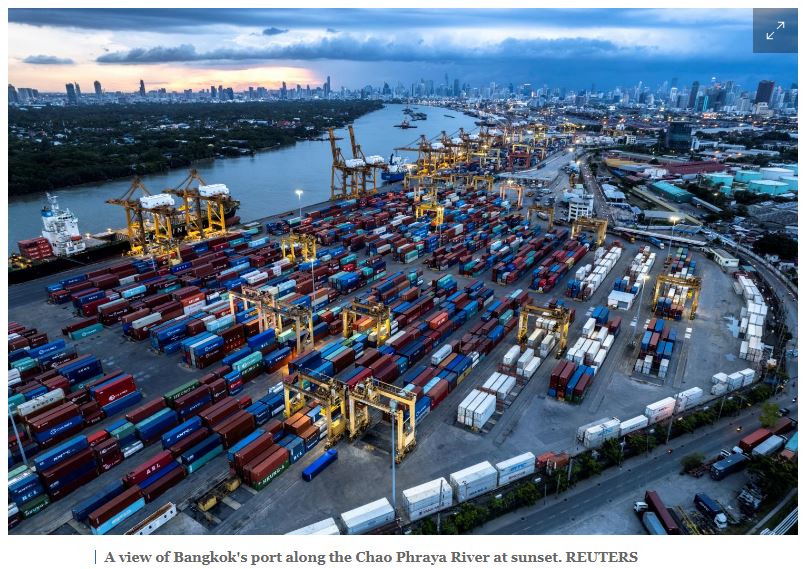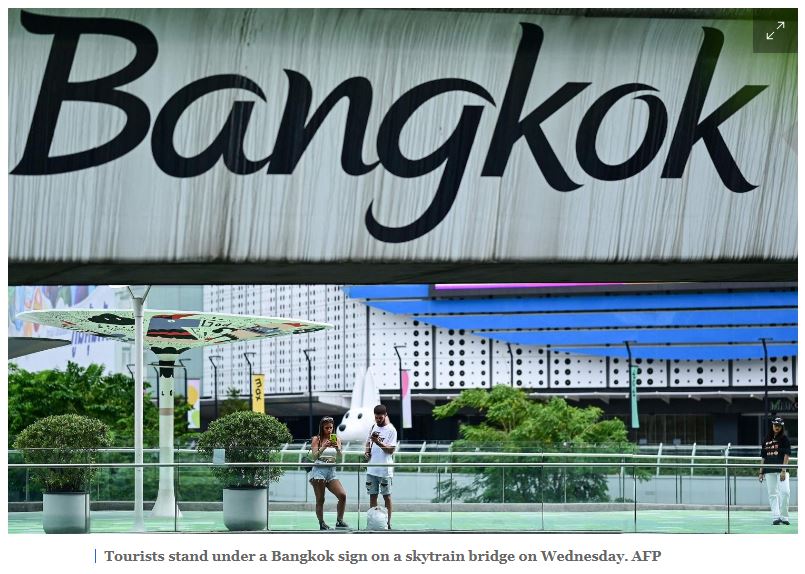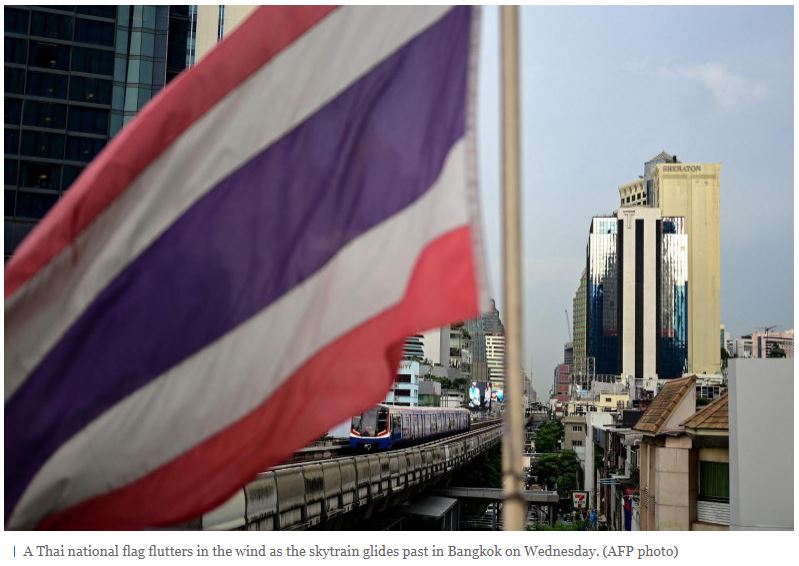Thai industry left at the altar
Heightened geopolitical tensions are tipped by some analysts and economists to trigger a spillover effect, with one possibility the relocation of industries to this region, including Thailand.
Payong Srivanich, chairman of the Thai Bankers’ Association, a key member of the Joint Standing Committee on Commerce, Industry and Banking, recently predicted tensions between China and the US over Taiwan could benefit Thai shipments and draw relocated investment to the region.
Apple supplier Foxconn and the US tech giant Apple Inc were among the latest foreign companies to make a move.
Foxconn last week reportedly signed a US$300-million memorandum of understanding with Vietnamese developer Kinh Bac City to expand its facility in northern Vietnam to diversify and boost production, while Apple Inc plans to start manufacturing the iPhone 14 in India as the firm seeks alternatives to China after the Xi administration’s clashes with Washington and lockdowns across the country disrupted production.
While the Thai government declared foreign investment is expected to be a key component in revitalising the country’s fragile economy, analysts have their doubts as to whether Thailand can entice overseas investors to choose the nation for industry relocation.
 DESTINATIONS ELSEWHERE
DESTINATIONS ELSEWHERE
A mix of factors, ranging from the economy to politics, is causing Thailand to lose out in attracting foreign investors looking for new destinations, said Tanit Sorat, vice-chairman of the Employers’ Confederation of Thai Trade and Industry.
“I have one simple answer. Thailand is no longer a favourable foreign investment destination,” said Mr Tanit, when asked whether Thailand has the potential to become a new production base if foreign companies decide to move out of China or Taiwan.
Though the government is promoting 12 targeted S-curve industries in the Eastern Economic Corridor (EEC), the country’s high-tech industrial hub, Thailand remains relatively less attractive than its Asean peers such as Vietnam and Indonesia, he said.
Other countries also offer investment privilege packages to investors, while Vietnam is granted better terms for the Generalized System of Preferences US trade programme than Thailand, which makes it an ideal place to export duty-free goods to America, said Mr Tanit.
Vietnam and Indonesia have larger domestic markets than Thailand, leading to higher potential demand for goods and services in those markets. From the perspective of investors, outlays are more worthwhile in those two countries than Thailand, given the promise of handsome revenue, he said.
Indonesia also has vast tracts of land for rent at inexpensive prices, helping entrepreneurs save on costs, Mr Tanit said.
“Even if foreign investors want to invest in Thailand, they may eventually change their minds because of local political instability, caused by conflicts among politicians and many rallies staged to oust governments,” he said.
One issue Mr Tanit is not worried about is the new technological skills of Thai labourers, saying it should not be a hindrance to the expansion of foreign businesses here.
He said investors do not care what vocational schools workers graduate from or whether teachers only explain the Industry 2.0 level, even as manufacturers increasingly focus on Industry 4.0 (the fourth industrial revolution), which encourages factory operators to blend digital technology with data analysis.
“I think investors with several billions of baht for a budget can train and build up new skills for their staff,” said Mr Tanit.
NOT TOO LATE
While acknowledging Thailand may be relatively less attractive to foreign investors than some of its neighbours, the Federation of Thai Industries (FTI) remains optimistic the country still has a chance to become a new production base for multinational companies if it tries harder.
If such factors as labour costs, land rents and total population are taken into consideration, it is difficult for Thailand to compete with Vietnam and Indonesia, said Kriengkrai Thiennukul, chairman of the FTI. Both have large domestic markets and less expensive labour and land prices.
Thailand’s pool of workers is also shrinking as the country becomes an ageing society.
Vietnam’s free trade agreements also cover more countries than Thailand’s international trade pacts. Thailand has yet to sign an agreement with the EU, causing some investors to choose Vietnam to export tariff-free products to Europe.
“Given these factors, we have lost the charm to draw investors to some extent,” said Mr Kriengkrai.
However, Thailand has other factors in its favour to make it an investment destination or new production base for foreign companies, he said.
Facilities such as deep-sea ports and airports, Thailand’s geographic location in the hub of Asean making product distribution simple, and ease of doing business are all important, said Mr Kriengkrai.
The latest tensions between China and Taiwan may cause some semiconductor producers to consider relocating their production facilities, with Asean an attractive choice, he said.
“We don’t know now which countries will be selected,” said Mr Kriengkrai. “But we need to speed up efforts before we lose opportunities.”
He believes it is not too late for Thailand to give itself a facelift to better attract foreign investors.
Mr Kriengkrai urges the government to develop infrastructure for electric vehicles (EVs) and make Thailand a key marketplace for these next-generation cars as it will help draw foreign investments in the EV industry.

STILL ATTRACTIVE
Duangjai Asawachintachit, secretary-general of the Board of Investment (BoI), reiterated that Thailand remains an attractive destination for foreign investors as indicated by continuous foreign investment, especially from China, the US and Taiwan.
“There have been continuous foreign investments in Thailand for a long time because it is the centre of the Asean region and is fully equipped with supply chains that are ready to support investments in various industries,” she said.
Foreign direct investment (FDI) tallied 455 billion baht from 783 project applications last year, nearly triple the value of the 169 billion from applications filed in 2020.
Japan again topped the list of FDI source countries with a combined investment value of 80.7 billion baht for 178 projects, followed by China with 38.6 billion in investment pledges for 112 projects.
Singapore was third at 29.7 billion baht for 96 projects.
The top three sectors for FDI applications were electrical appliances and electronics, petrochemicals and chemicals, and the medical cluster.
In the first half of this year, there were investment applications for 395 projects of FDI with a combined value of more than 130 billion baht.
Taiwan was the main source of FDI applications during the period with 19 projects worth a combined 38.5 billion baht, accounting for 30% of FDI project value.
Next came Japan, China, the US and Singapore, with investment values of 16.9 billion baht, 15.5 billion, 11.3 billion and 8.7 billion, respectively.
According to Ms Duangjai, Foxconn already invested in Thailand through a joint venture with national oil and gas conglomerate PTT Plc to develop an EV production facility worth 36.1 billion baht in the EEC.
The government set a clear target to drive Thailand to become a production base for the EV industry, especially EV cars with right-hand drive, she said.
STRATEGIC FOCUS NEEDED
Niti Mekmok, president of the Thai IoT (Internet of Things) Association, said tech companies consider various issues before choosing a country for investment, including overall industry supply chain, labour and logistics costs, materials, workforce skills, working age population, intellectual property protection and modern machinery.
Many companies are interested in investing in Vietnam because the country has a large pool of young, hard-working people, he said.
In Thailand, some workers want easy money without working hard, Mr Niti said.
He said Thailand should focus more on high-value technology development, shifting away from being an original equipment manufacturer towards original design manufacturing, while gearing up for brand-building, creative industries, the bio-, circular and green economic model and EV production.
Principally, the country has to scale up its value chain efficiency; decrease logistics costs below 10% of the country’s GDP, down from 10-13% at present; and increase the workforce with software and programming skills, said Mr Niti.
He said policymakers should consider increasing the budget to encourage industries to upgrade their machinery from Industry 2.0 to 4.0, capitalising on data analytics for manufacturing planning and automation.
Some US cloud providers have moved to invest in Thailand as this business does not require a large supply chain, focusing instead on data centres, said Mr Niti.
Sarun Sutuntivorakoon, president of the Thai Venture Capital Association, said Thailand needs to strategically focus on specific industries as the country now engages with too many S-curve industries, compared with Vietnam which strategically concentrates on key industries.
Vietnam also has a large pool of young workers with lower labour costs and higher skill resources, while being geopolitically allied with the US, Mr Sarun said.
Other advantages include Vietnam’s large domestic market with potential purchasing power and a high GDP growth rate over the past few years, he said.
Thanachart Numnonda, executive director of IMC Institute, a local research and tech training firm, said Thailand is marred by a labour shortage, high labour costs and political instability, making it an unlikely destination for foreign investments at present.
Source: https://www.bangkokpost.com/business/2379146/thai-industry-left-at-the-altar


 English
English




